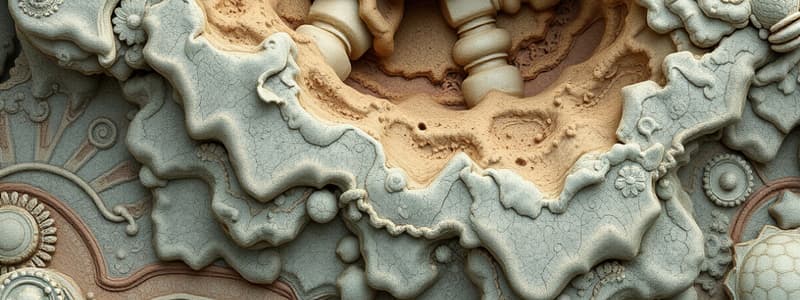Podcast
Questions and Answers
What is weathering?
What is weathering?
Weathering is the process that breaks down rocks.
What are the two main types of weathering?
What are the two main types of weathering?
Physical and chemical.
What is erosion?
What is erosion?
Erosion is when sediments are moved from their current location.
What process forms the particles that are involved in erosion?
What process forms the particles that are involved in erosion?
What is deposition?
What is deposition?
What is the main force that causes erosion and deposition?
What is the main force that causes erosion and deposition?
What are the three main agents of erosion?
What are the three main agents of erosion?
What is a delta?
What is a delta?
How do weathering, erosion, and deposition work together to form a delta?
How do weathering, erosion, and deposition work together to form a delta?
Define oxbow lakes and meanders.
Define oxbow lakes and meanders.
What is a glacier?
What is a glacier?
Define till.
Define till.
Define an alpine glacier.
Define an alpine glacier.
Describe a continental glacier.
Describe a continental glacier.
How does a glacier change a valley?
How does a glacier change a valley?
Describe how a moraine forms.
Describe how a moraine forms.
What are the two types of glacier movements?
What are the two types of glacier movements?
What percentage of Earth do glaciers cover?
What percentage of Earth do glaciers cover?
What is a glacial erratic?
What is a glacial erratic?
How does a kettle lake form?
How does a kettle lake form?
Define and identify examples of weathering, erosion, and deposition.
Define and identify examples of weathering, erosion, and deposition.
Identify a meander and an oxbow lake, and explain how oxbow lakes form.
Identify a meander and an oxbow lake, and explain how oxbow lakes form.
Identify a river delta and describe how it forms.
Identify a river delta and describe how it forms.
What is erosion?
What is erosion?
What process forms the particles that are involved in erosion?
What process forms the particles that are involved in erosion?
How does a moraine form?
How does a moraine form?
Flashcards are hidden until you start studying
Study Notes
Weathering
- Weathering breaks down rocks into smaller pieces.
- Two main types: physical weathering (changes shape) and chemical weathering (changes composition).
Erosion
- Erosion involves the movement of sediments from one location to another.
- Weathering is the process that generates the sediments transported during erosion.
Deposition
- Deposition occurs when sediments are settled in a new location.
Agents of Erosion
- Gravity is the primary force driving erosion and deposition.
- Main agents include wind, water, and ice.
Delta Formation
- A delta forms at the mouth of a river, characterized by a fan-shaped sediment deposit.
- Weathering breaks down rocks, erosion transports these sediments, and deposition occurs at the river's mouth.
Oxbow Lakes and Meanders
- An oxbow lake is a crescent-shaped lake formed when a meander is bypassed.
- Meanders are curves in river channels; oxbow lakes are formed from abandoned bends of river paths.
Physical vs. Chemical Weathering
- Both types break down rock but differ in impact: physical weathering alters shape, whereas chemical weathering modifies composition.
Glaciers
- Glaciers are massive ice formations that flow over land.
- Two types: alpine glaciers (form in mountains, create U-shaped valleys) and continental glaciers (cover large areas, known as ice sheets).
Glacier Impact on Valleys
- Glaciers can transform V-shaped valleys into U-shaped valleys through erosion.
Moraine Formation
- Moraines are formed from till, sediment left by retreating glaciers.
- Types of moraines include lateral (sides), end (terminus), and ground (beneath the glacier).
Glacier Movement
- Glaciers move through two primary movements: flowing (internal deformation) and sliding (base movement).
- Glaciers cover about 10% of Earth's surface.
Glacial Erratics
- Glacial erratics are large boulders displaced by glacier movement, left behind after melting.
Kettle Lake Formation
- Kettle lakes form when a block of ice creates a depression that subsequently fills with water after melting.
Summary of Weathering, Erosion, and Deposition
- Weathering: breakdown of rocks into sediments.
- Erosion: transportation of sediments away from their original place.
- Deposition: resting of sediments in a new location.
Meander and Oxbow Lake Formation
- Meanders are curves created by water eroding soil.
- Oxbow lakes form when water flows a new path, isolating a meander.
River Delta
- River deltas are fan-shaped packets of sediments at river mouths, formed by the interplay of weathering, erosion, and deposition.
Additional Definitions
- Erosion defined as the movement of sediments, while weathering creates sediments via rock breakdown.
- Moraines result from sediment left by melting glaciers, including lateral, end, and ground formations.
Studying That Suits You
Use AI to generate personalized quizzes and flashcards to suit your learning preferences.




